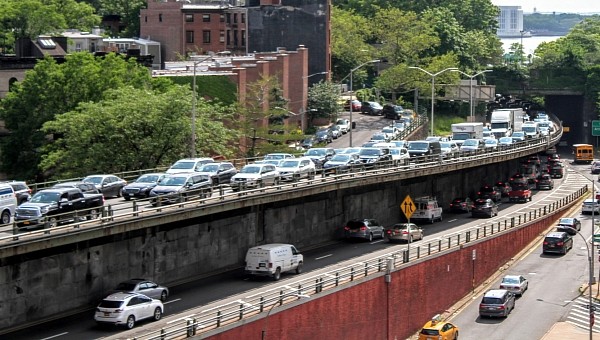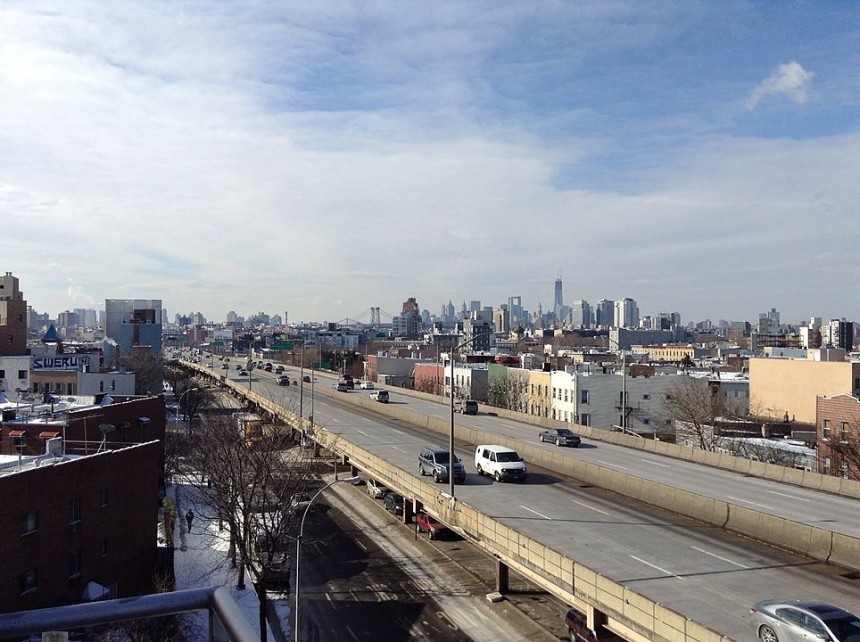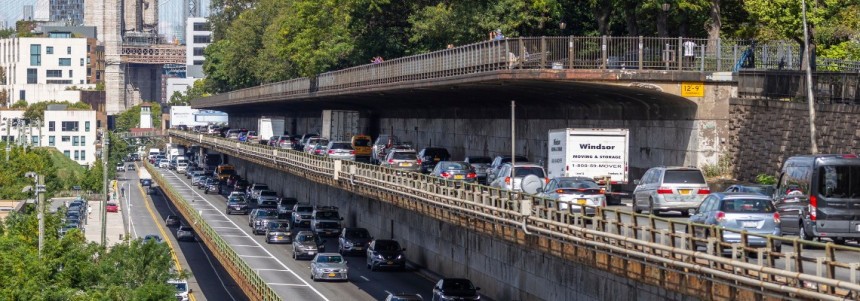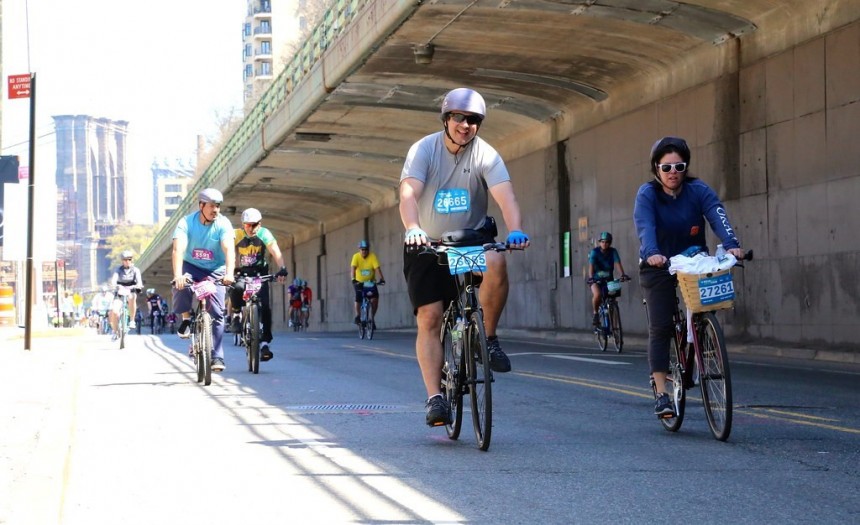Last year, we told the story behind the Cross Bronx Expressway. A section of New York City freeway with a dark reputation held in part by its seemingly endless hideous accidents, bumper-to-bumper gridlock, and splitting historic neighborhoods in half.
But New York City's automotive infrastructure has been notorious for "not being in great shape" for decades now. If you can believe it, there's another section of NYC highway that's even more reviled, at least by locals. Tourists and country folk of all ages, say hello to the Brooklyn Queens Expressway. The bane of every city-slicker commuter's existence.
As it's not so lovingly called, the BQE would look like an unassuming 11.7-mile (18.8-km) stretch of U.S. Interstate 278 to the average outsider. A pot-hole riddled and unforgiving stretch of asphalt spanning either direction between the Grand Central Parkway in the Borough of Queens to the Brooklyn-Battery Tunnel in the Red Hook section of Brooklyn.
At least, that's a good descriptor for what the BQE looks like today. At the start, the Brooklyn Queens Expressway was another brainchild of Robert Moses. Locals mostly remember Moses as perhaps the most polarizing urban developer in all human history. A man who was known for unrepentantly building sprawling highways in New York City right through the hearts of ethnically diverse neighborhoods, among other grievances.
It was all part of a series of upsetting grievances documented in the tell-all book The Power Broker by Robert Caro. The effects of Moses' road and highway system are still an everyday part of life for New Yorkers not fortunate enough to live in the more sanitized parts of the city. In many cases, as with the Cross Bronx, this meant local neighborhoods became starkly divided down racial barriers on either side of the city's dozens of arterial highways, freeways, and interstates.
The BQE's first section opened on May 25th, 1950, was completed by 1954, and fully integrated into the federally funded Interstate system by 1959. Robert Moses touted his latest creation as the gold standard of inter-city automotive transportation. Envisioning it as a road with all the benefits of modern high-speed driving with none of the downsides. But as life-long locals will tell you, their side tells a different story.
But in the case of the BQE, the biggest bone of contention isn't its dubious placement right through the middle of working-class neighborhoods. However, it was certainly guilty of doing so. Instead, it's the sheer state of decay of the thing.
In a land lauded for the largest financial sector in history, non-locals may be shocked to learn the BQE is one of the worst maintained stretches of road in any of the developed world's major cities. By West European or East Asian standards, things are nothing short of horrific.
Design changes that spared residentially and business space in the Brooklyn Heights neighborhood did little to spare its neighboring communities along the iconic East River from facing the bulldozer. Making way for elevated sections of the newly christened I-278. As the only highway of any significance between sprawling sections of Queens and Brooklyn, the result is a road that can not be shut down to repair for any length of time. Lest the residential streets of the surrounding city suddenly descend into automotive anarchy.
To make matters worse, large cargo vans and trucks have no choice but to jam up the BQE with their non-stop deliveries. This further brutalizes road infrastructure that started screaming uncle as far back as the late 1980s. With as much as 15 percent of BQE traffic consisting of freight, this is an obvious point of stress for points of the road held aloft in portions by enormous concrete pillars.
In other sections, a series of three stacked, bespoke roadways in a triple cantilever configuration makes for a stunning display. One whose moldy concrete blocks and rusty steel girders show off the sheer decay the road endures day in and day out. In this scenario, the clear, most horrifying danger is any of these sections experiencing catastrophic failure during rush hour.
In a country with an independently-judged infrastructure score of C-, it's an exclamation mark on a problem that's spread nationwide. That's without mentioning the BQE's reputation for hosting some truly horrendous car accidents. In 2016, a man stranded on the highway was struck and killed, unable to avoid the torrent of oncoming traffic around their immobilized vehicle.
A more recent 2020 incident involved a man who drove the wrong way onto one of the BQE's exit ramps in the Queens neighborhood of Woodside. His injuries were fatal. Between Brooklyn and Queens, the two boroughs are host to more than half of all of New York City's traffic collisions. Among them, the Brooklyn Queens Expressway has more than its fair share.
It's just another feather in the cap of a road that's almost completely unknown to tourists or outsiders. Bless their hearts; they get to avoid the road whether they realize it or not.
As it's not so lovingly called, the BQE would look like an unassuming 11.7-mile (18.8-km) stretch of U.S. Interstate 278 to the average outsider. A pot-hole riddled and unforgiving stretch of asphalt spanning either direction between the Grand Central Parkway in the Borough of Queens to the Brooklyn-Battery Tunnel in the Red Hook section of Brooklyn.
At least, that's a good descriptor for what the BQE looks like today. At the start, the Brooklyn Queens Expressway was another brainchild of Robert Moses. Locals mostly remember Moses as perhaps the most polarizing urban developer in all human history. A man who was known for unrepentantly building sprawling highways in New York City right through the hearts of ethnically diverse neighborhoods, among other grievances.
It was all part of a series of upsetting grievances documented in the tell-all book The Power Broker by Robert Caro. The effects of Moses' road and highway system are still an everyday part of life for New Yorkers not fortunate enough to live in the more sanitized parts of the city. In many cases, as with the Cross Bronx, this meant local neighborhoods became starkly divided down racial barriers on either side of the city's dozens of arterial highways, freeways, and interstates.
But in the case of the BQE, the biggest bone of contention isn't its dubious placement right through the middle of working-class neighborhoods. However, it was certainly guilty of doing so. Instead, it's the sheer state of decay of the thing.
In a land lauded for the largest financial sector in history, non-locals may be shocked to learn the BQE is one of the worst maintained stretches of road in any of the developed world's major cities. By West European or East Asian standards, things are nothing short of horrific.
Design changes that spared residentially and business space in the Brooklyn Heights neighborhood did little to spare its neighboring communities along the iconic East River from facing the bulldozer. Making way for elevated sections of the newly christened I-278. As the only highway of any significance between sprawling sections of Queens and Brooklyn, the result is a road that can not be shut down to repair for any length of time. Lest the residential streets of the surrounding city suddenly descend into automotive anarchy.
In other sections, a series of three stacked, bespoke roadways in a triple cantilever configuration makes for a stunning display. One whose moldy concrete blocks and rusty steel girders show off the sheer decay the road endures day in and day out. In this scenario, the clear, most horrifying danger is any of these sections experiencing catastrophic failure during rush hour.
In a country with an independently-judged infrastructure score of C-, it's an exclamation mark on a problem that's spread nationwide. That's without mentioning the BQE's reputation for hosting some truly horrendous car accidents. In 2016, a man stranded on the highway was struck and killed, unable to avoid the torrent of oncoming traffic around their immobilized vehicle.
A more recent 2020 incident involved a man who drove the wrong way onto one of the BQE's exit ramps in the Queens neighborhood of Woodside. His injuries were fatal. Between Brooklyn and Queens, the two boroughs are host to more than half of all of New York City's traffic collisions. Among them, the Brooklyn Queens Expressway has more than its fair share.








